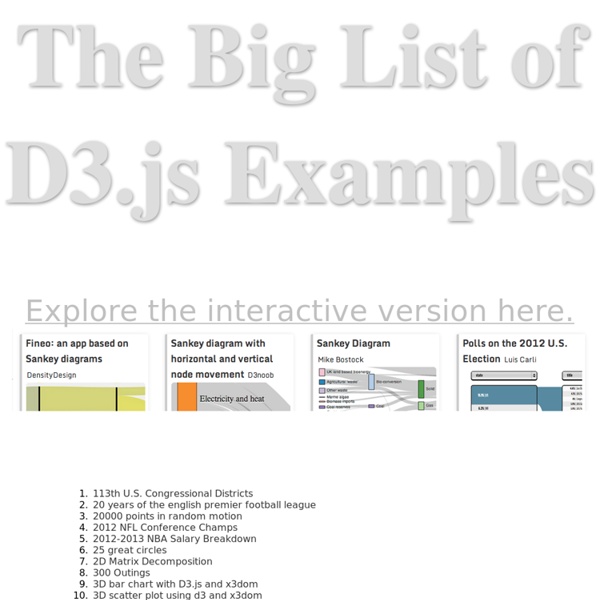



D3.js Gallery Wiki ▸ Gallery Welcome to the D3 gallery! More examples are available for forking on Observable; see D3’s profile and the visualization collection. Visual Index Basic Charts Techniques, Interaction & Animation Maps Statistics Examples Collections The New York Times visualizations Jerome Cukier Jason Davies Jim Vallandingham Institute for Health Metrics and Evaluation Peter Cook Charts and Chart Components Bar Chart Histogram Pareto Chart Line and Area Chart Pie Chart Scatterplot and Bubble chart Parallel Coordinates, Parallel sets and Sankey Sunburst and Partition layout Force Layout Tree Misc Trees and Graphs Chord Layout (Circular Network) Maps Misc Charts Miscellaneous visualizations Charts using the reusable API Useful snippets Tools Interoperability Online Editors Products Store Apps Libraries Games Wish List
D3.js D3.js (or just D3 for Data-Driven Documents) is a JavaScript library that uses digital data to drive the creation and control of dynamic and interactive graphical forms which run in web browsers. It is a tool for data visualization in W3C-compliant computing, making use of the widely implemented Scalable Vector Graphics (SVG), JavaScript, HTML5, and Cascading Style Sheets (CSS3) standards. It is the successor to the earlier Protovis framework.[2] In contrast to many other libraries, D3 allows great control over the final visual result.[3] Its development was noted in 2011,[4] as version 2.0.0 was released in August 2011.[5] Context[edit] The first web browsers appeared in the early 1990s. At the same time, researchers, engineers, and practitioners from various branches of engineering and science looked for tools that would enable web browsers to visually present data within web pages. In 2011, the development of Protovis was stopped to focus on a new project, D3.js. Selections[edit]